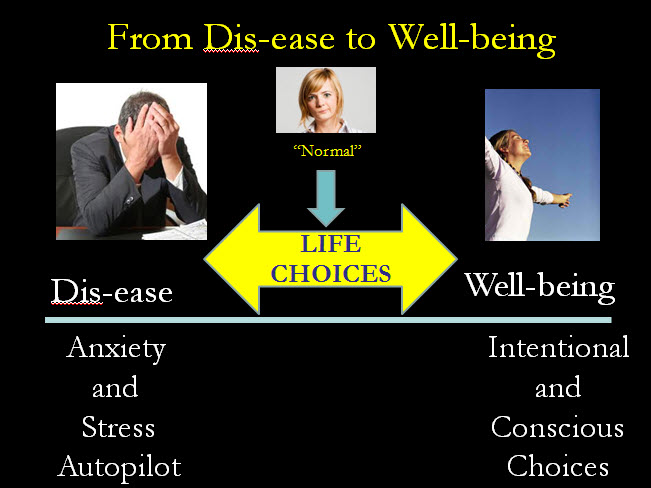THE MINDFUL CHOICES THERAPY MODEL |
 |
|
It’s all about choices! Life is all about choices, and our 10 Mindful Choices, are actually 10 choice areas that constitute virtually hundreds of choices you could make that would be helpful in dealing with stress, anxiety and depression, or simply improving the quality of your life.
Getting to those choices however requires mindful awareness of the present moment, and acceptance of whatever you find there. It means noticing your thoughts, feelings and images, and the stories you tell yourself, without needing to avoid them, distract yourself, judge yourself or others, or struggle against what you’re experiencing. It means having the ability to step back and calmly observe your thoughts, feelings, images and stories, responding to them in terms of usefulness and workability, rather than being all caught up in trying to determine whether or not they are literally true. It means recognizing that your mind is constantly busy generating thoughts, helpful and unhelpful, and saying to yourself: “I’m noticing that my mind is telling me…,” rather than automatically accepting what your mind is telling you as literally and absolutely true. It means having the flexibility to not automatically go with what your mind is telling you, but instead move actively in the direction of your values, and in the direction of choices that serve you well. It means not being dominated by your thoughts, but having the choice to choose an entirely different direction. The following chart represents the Mindful Choices Model. We will walk you through the model from left to right. The circle in the upper left portion of the chart represents situations you find yourself in, events that impact you, either positively or negatively. Life is about continuously responding, reacting and choosing. Most events are routine and require only a routine response. Some events however, set in motion mental activity leading to stress, anxiety or depression. Your mind is not always your friend.  Whatever happens in your life is processed through the filter of past learning and experience, beliefs about yourself and the world, and attitudes you have formed over time. As a result, thoughts, feelings, and images are generated. Also, you may tell yourself “stories” which have a lot to do with your interpretation of events. Some of these “stories” represent maladaptive “schema,” complex patterns of cognitive, behavioral, and emotional elements that usually start in childhood and reverberate throughout life. When schema are triggered by present events, you may find yourself responding with old and possibly dysfunctional and destructive patterns of behavior, and old disturbing feelings. Often, automatic negative self talk occurs at lightning speed, with instantaneous disturbing feelings if you readily buy into what your mind is telling you. This is a point where our model draws heavily upon Acceptance and Commitment Therapy (ACT), particularly the work of Russ Harris, author of The Happiness Trap. The basic premise of ACT is that you don’t have to do battle with negative thoughts, feelings and images. Instead, you need to accept their existence without allowing them to dominate your behavior. You simply respond to them in terms of workability, rather than having to determine how true they are. You don’t have to struggle with them, and you don’t have to avoid them. You simply notice them, make space for them, and choose to move in the direction of your values. ACT is central to our work and we will be referring to ACT concepts such as “fusion” and “defusion” throughout the book. It all comes down to noticing, and remembering to slow down and notice. Do you take time out of all of your doing to just be–and notice? What do you notice about your life? Are you self-aware? Do you notice your emotions? Do you know how you feel from moment to moment? Can you observe your own thoughts? Are you able to step back and observe your life in a calm and reflective manner? Are you fully present in the here and now? Are you mindful? "How is life?" Bill begins most sessions with the same question. Many assume it's just small talk, but it's a serious question. Most of the people we see aren't too happy with the state of their lives. It seems easier than ever before to feel stressed out and overwhelmed. We live in a high-stress society, and by all measures it seems to be getting worse. Most of us are running hard just to keep up amid ever-increasing challenges and pressures. We're all familiar with the sayings: "Wake up and smell the coffee," or: "Stop and smell the roses." These are sayings that have been around for at least 100 years and no one knows for sure their origin. It seems some of us have always had a problem with moving too fast to really pay attention to what's happening in our lives, but these sayings seem to have special relevance in the 21st century. Much of our stress is self generated, but largely unnecessary. Our "Life Choices" Model shows a pathway from the initial experiencing of events to either self-imposed "dis-ease," or values-driven choices for overcoming stress, anxiety and depression and achieving well-being. The simple act of Noticing is the turning point. We constantly respond to events or situations, and we perceive those events through a filter of past learning, beliefs, and attitudes. We add thoughts, feelings, and images associated with the situation and add self-talk that is sometimes distorted or even irrational. Yes, each of us can be irrational. Being human means we all have the tendency to deny, distort, or falsify reality on a fairly regular basis, and particularly when we perceive things to be threatening to our well-being or sense of self. Often, we are on autopilot, responding in a stereotypical way, and not realizing that our stress, anxiety, and depression often results from “cognitive fusion” with automatic negative self talk. Russ Harris in ACT Made Simple, a Primer on Acceptance and Commitment Therapy, states: “Cognitive fusion basically means that our thoughts dominate our behavior.” In cognitive fusion there is no separation between thoughts and self, and thoughts are seen as absolute truth or commands that have to be obeyed. Defusion on the other hand means seeing thoughts as only thoughts, something your mind is telling you that may or may not be true, not a command that has to be obeyed, and not a dire threat.” At the very center of our chart is "noticing," bringing the present moment clearly into view. Noticing isn't ruminating on the past or anticipating the future. It's simply checking in with yourself and being fully present in the "here and now." Without "noticing" it's all too easy to get caught up in mindless automatic self talk, much of it self-distressing and distress perpetuating. Noticing is a learned skill, opening the door to mindful awareness. No skill matters more.  Noticing begins the process of defusion of negative self talk, within the context of mindful awareness. Once you are able to tell yourself that you are noticing that your mind is telling you certain things, things that may be hurtful or impractical, you are in a position to make values-based choices. For example, John has difficulty with his boss. When his boss is critical, John automatically says to himself: "I'm incompetent. I can't do anything right. I'm going to be fired for sure." Consequently, John suffers from extreme stress and high levels of anxiety and depression. Suppose on the other hand, that John is well-practiced in noticing his negative self talk. Further suppose that John is able to take three deep breaths, take a step back from being "fused" with the negative self talk, and instead say to himself: "I'm noticing that my mind is telling me I'm incompetent." John has now set the stage for defusing the automatic negative thoughts. He's able to consider whether the thoughts work for him or whether he would be better served by an alternative way of thinking. He's able to accept the negative thought, make room for it, but move ahead anyway, fully engaging with life based upon accurate information and a clear awareness of values-driven choices. Without noticing and diffusion, you may find yourself automatically responding to negative self talk and caught up in an endless loop of self-imposed distress, living your life on “autopilot.”  The following chart illustrates not separating yourself from your thoughts, and being so caught up in automatic negative thoughts and predictable self-talk that destructive or ineffective choices may be made, choices that in turn reinforce old perceptions, beliefs, and behaviors. Our clients refer to this as “the Racetrack,” distressing thoughts going round and round, picking up speed, making panicky thoughts increasingly likely.  Noticing your distress within the context of self-calming skill and mindful awareness is the key. Both self calming skill and mindful awareness are learned and practiced skills you can continue to improve upon. So, want to get really good at noticing? Frequently take three deep diaphragmatic breaths and check in with yourself. Slow yourself down and take a moment to notice what you're telling yourself, and what you're feeling. Accept your thoughts and feelings, make room for them, but then consider your choices. Values-driven choices are made possible by being in a calm, accepting place, a place that allows careful reflection and choosing to live your life with full consciousness, clear intention, and what Rollo May refers to as "real freedom." “Real freedom is the ability to pause between stimulus and response, and in that pause, to choose.” Rollo May Choices, Good Ones and Bad Ones There are always choices. No matter what is going on, no matter what problem or life difficulty you are facing, no matter how much distress you are in, there are one or more of their 10 Life Choices that can help. These are values-driven choices and they will make a difference. Guaranteed! However, not all choices work well for you, and you may find yourself making choices which help you feel better or safer in the moment, but greatly increase your stress, anxiety or depression in the long run. Consider the following chart.  Some people remain on the racetrack, experiencing high levels of stress, anxiety or depression. Many choose unhealthy “off-ramps.” Our program is all about noticing, defusing, and then choosing to be actively involved in values-based choices. As indicated by the following chart, our 10 Life Choices, actually constitute sets of values. Some you may already embrace. Others, we are actively promoting. Values have to be freely, chosen from among alternatives. We will do our best to influence you to choose and act upon our 10 Life Choices.  As we have stated repeatedly, it’s all about choices. Our program is about helping you become very aware of present choices and consequences, and consistently make values-based choices. Our self-assessment helps you be clear on where you’re at. Self calming skill and mindfulness training helps you break free from thoughts, feelings, images and stories that don’t serve you very well. Choosing and actively engaging in living your values helps you transform your life to a life truly worth living. Revolutionary in its simplicity Mindful Choices Therapy is transformational in five ways: 1. Our monthly Mindful Choices assessment yields a profile where you can see at a glance which Life Choices most need attention. 2. A daily focus on specific Mindful Choices, which includes working with an Action Planning Guide, results in steady improvement in the choice areas which will make the most difference in your life. 3. The 10 Mindful Choices are interrelated. This means that when working on one, you’ll probably see improvement in others as well. This will be especially apparent each month when you retake the assessment. You will most probably find that your overall score has improved, and you are further along on your Mindful Choices Roadmap. 4. Noticing stress, anxiety and depression creates an opportunity for growth. Training in mindfulness skills and the ACT skill of defusion paves the way for values-based choices – most probably the very same choices identified as needing attention in your Mindful Choices Assessment. 5. Over time, developing a solid working knowledge of each of the 10 Mindful Choices results in familiar and well-practiced choice areas readily available when encountering stress, anxiety or depression. You’ll find you have a clear choice between old choices that don’t work as well and values-based choices. Altogether, you will find yourself moving from a life largely on autopilot, to a life that is being lived on purpose, a life that is rich and satisfying. You are a work in progress. Don't judge yourself harshly if change takes time. It always does. The hardest thing about mindfulness is simply noticing the need to be mindful, followed by defusion. With practice, you get better at noticing, and with noticing and defusion comes mindful awareness and mindful choices – and that changes everything! Carpe Diem! |






